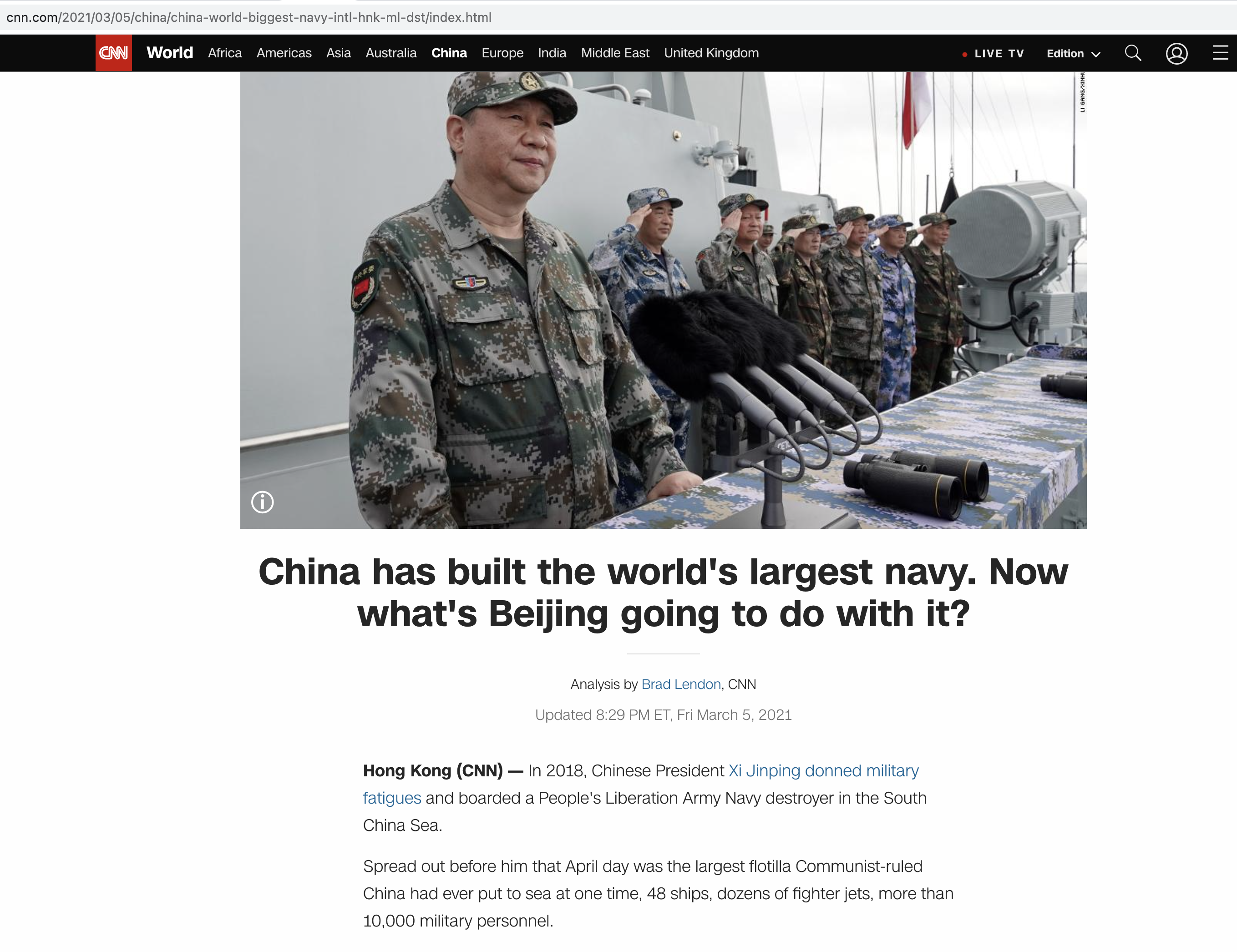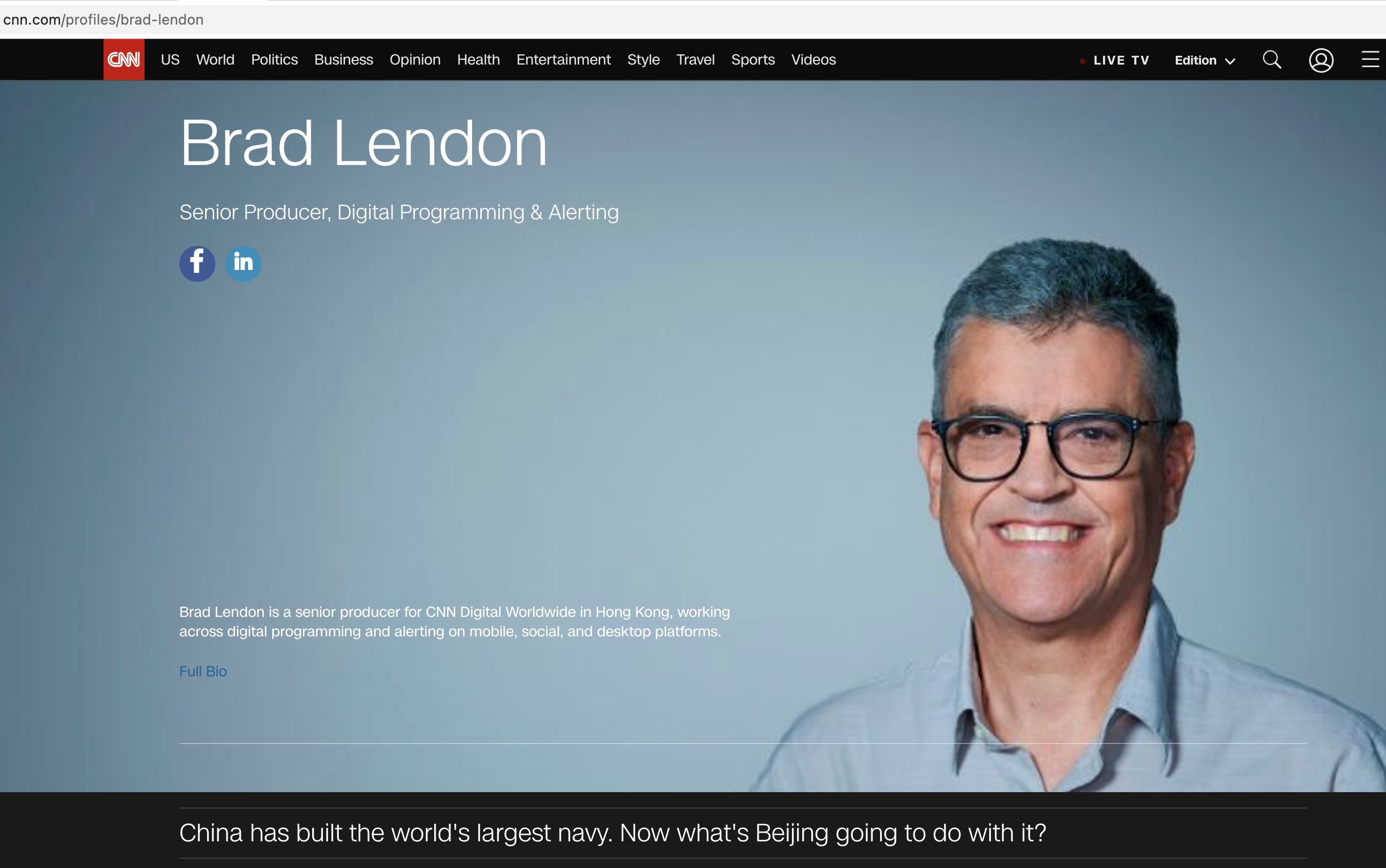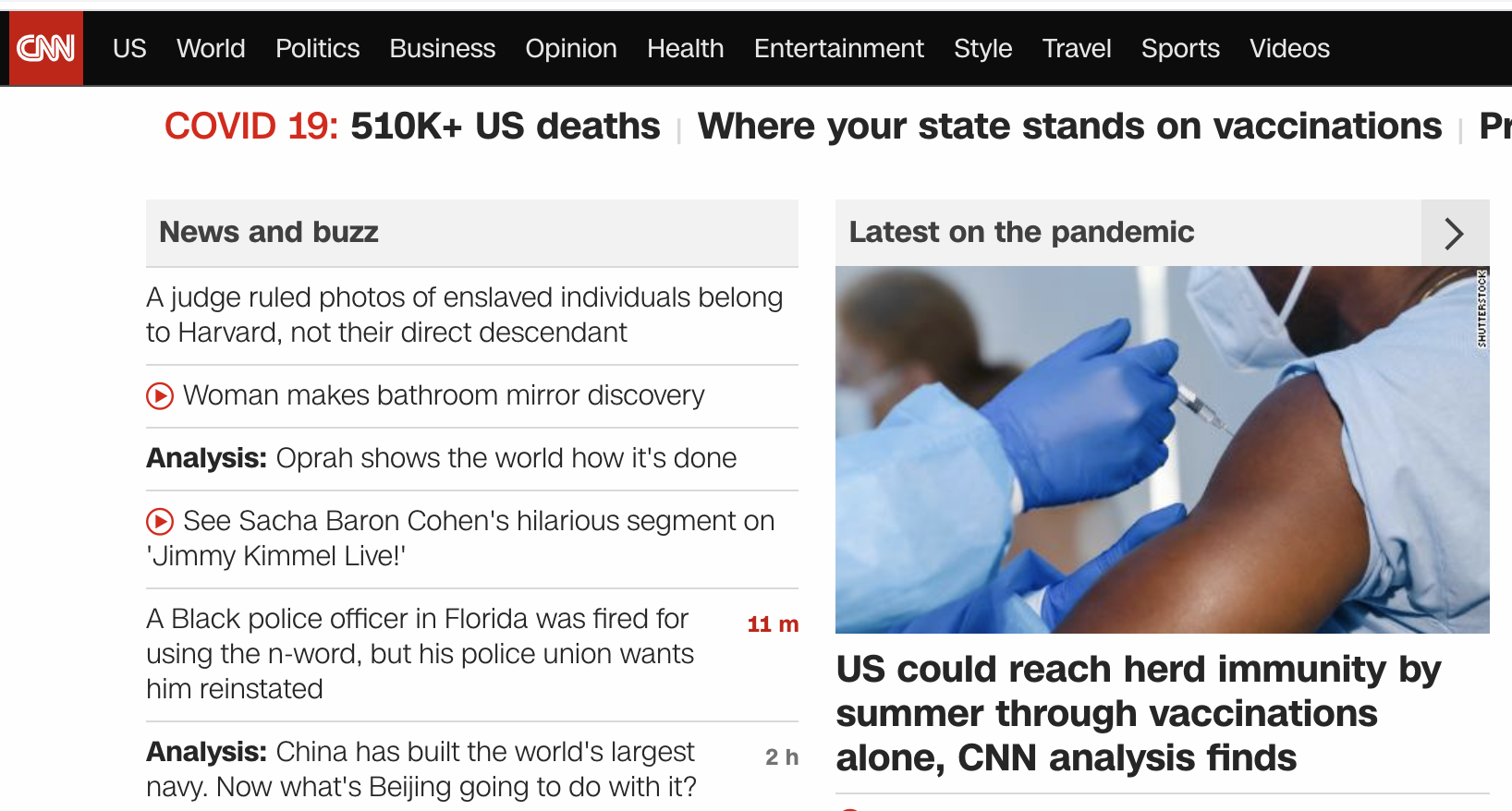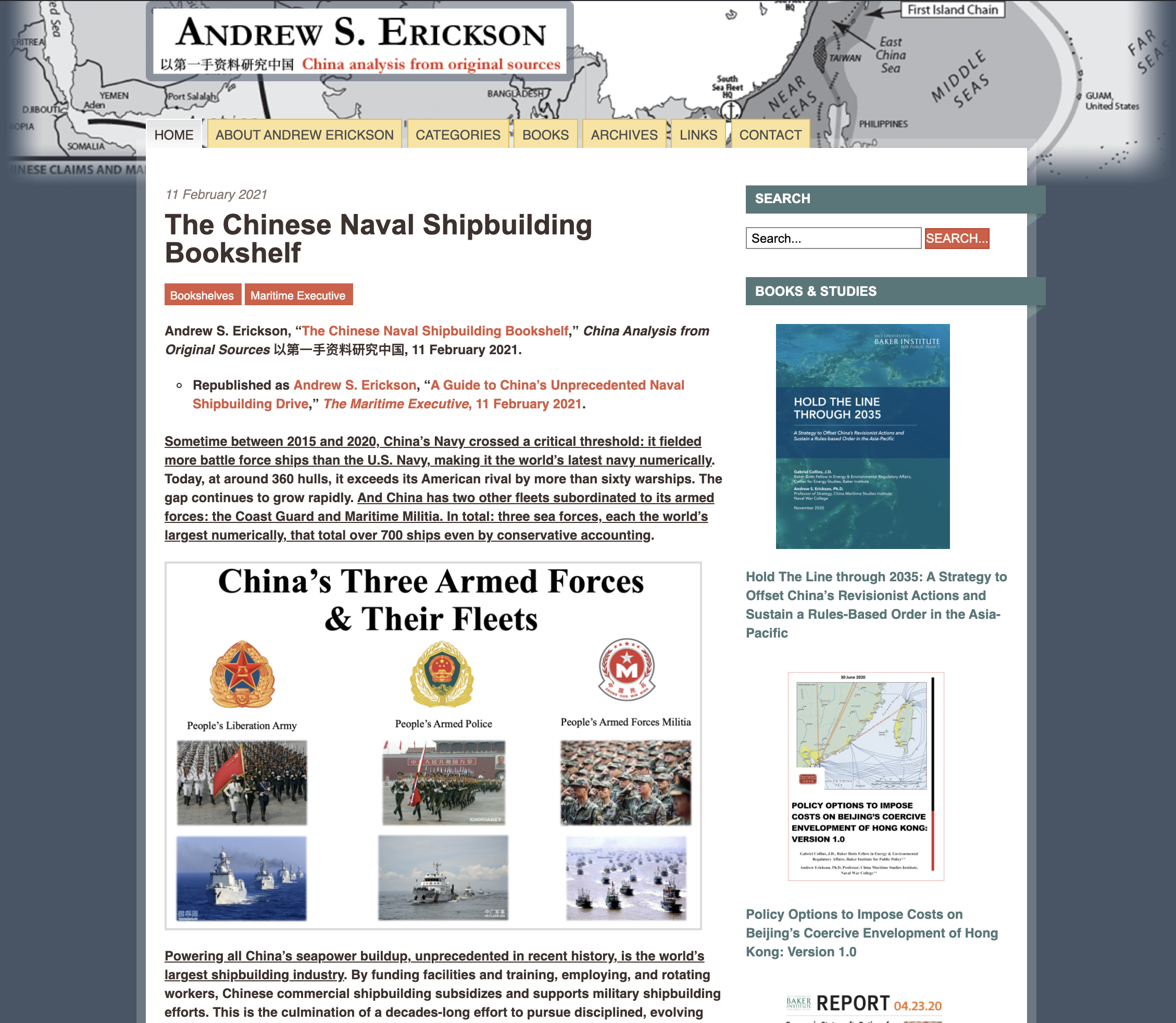China Has Built the World’s Largest Navy. Now What’s Beijing Going to Do With It?
Honored to be included in this tour de force treatment of a timely topic, with a dream team of experts quoted in-depth!
- Great to see extensive coverage of CMSI’s latest China Maritime Report, by top Office of Naval Intelligence analysts Jennifer Rice and Erik Robb!
- Here’s my latest Chinese Naval Shipbuilding Bookshelf, as cited in the feature article.
- For extensive discussion of metrics and methodology for comparing navies’ size and capabilities, see the sections I highlight from Ron O’Rouke’s Congressional Research Service report on China Naval Modernization.
Brad Lendon, “China Has Built the World’s Largest Navy. Now What’s Beijing Going to Do With It?” CNN, 5 March 2021.
Hong Kong (CNN) In 2018, Chinese President Xi Jinping donned military fatigues and boarded a People’s Liberation Army Navy destroyer in the South China Sea.
Spread out before him that April day was the largest flotilla Communist-ruled China had ever put to sea at one time, 48 ships, dozens of fighter jets, more than 10,000 military personnel.
For Xi, the country’s most powerful leader since Mao Zedong, the day was a way point to a grand ambition — a force that would show China’s greatness and power across the world’s seven oceans.
“The task of building a powerful navy has never been as urgent as it is today,” Xi said that day.
China was already in the midst of a shipbuilding spree like few the world has ever seen. In 2015, Xi undertook a sweeping project to turn the PLA into a world-class fighting force, the peer of the United States military. He had ordered investments in shipyards and technology that continue at pace today.
By at least one measurement, Xi’s plan has worked. At some point between 2015 and today, China has assembled the world’s largest naval force. And now it’s working to make it formidable far from its shores.
In 2015, the People’s Liberation Army Navy (PLAN) had 255 battle force ships in its fleet, according to the US Office of Naval Intelligence (ONI).
As of the end of 2020, it had 360, over 60 more than the US Navy, according to an ONI forecast.
Four years from now, the PLAN will have 400 battle force ships, the ONI predicts. …
“The PLAN is not receiving junk from China’s shipbuilding industry but rather increasingly sophisticated, capable vessels,” Andrew Erickson, a professor at the US Naval War College’s China Maritime Studies Institute, wrote in a February paper. … …
Where the US stands
While China is expected to field 400 ships by 2025, the goal of the current US Navy shipbuilding plan, a goal with no fixed date, is for a fleet of 355 — a substantial numerical disadvantage.
That’s not to say the US Navy has seen its days as the world’s premier fighting force come to an end. …
Analysts point out several… factors in Washington’s favor. … …
Nobody can match China’s shipbuilding
You can’t have the world’s largest navy if you can’t build a lot of ships. China gives itself that ability by being the world’s largest commercial shipbuilder.
In 2018, China held 40% of the world’s shipbuilding market by gross tons, according to United Nations figures cited by the China Power Project at the Center for Strategic and International Studies, well ahead of second place South Korea at 25%.
Put in a historical perspective, China’s shipbuilding numbers are staggering — dwarfing even the US efforts of World War II. China built more ships in one year of peace time (2019) than the US did in four of war (1941-1945).
“During the emergency shipbuilding program of World War II, which supported massive, mechanized armies in two theaters of war thousands of miles from home, US shipbuilding production peaked at 18.5 million tons annually, and the United States finished the war with a merchant fleet that weighed in at 39 million tons,” said Thomas Shugart a senior fellow at the Center for a New American Security and former US Navy captain, in testimony before Congress last month.
“In 2019, during peacetime, China built more than 23 million tons of shipping, and China’s merchant fleet … totals more than 300 million tons,” Shugart said.
The Chinese state-owned companies churning out commercial shipping are also the engines of its naval buildup.
“In conflict, excess PRC industrial capacity, including additional commercial shipyards, could quickly be turned toward military production and repair, further increasing China’s ability to generate new military forces,” Erickson, of the US Naval War College, wrote last year. [*Quoting directly with explicit attribution from p. 4 of Advantage at Sea: Prevailing with Integrated All-Domain Naval Power (Washington, DC: U.S. Navy, U.S. Marine Corps, and U.S. Coast Guard, 17 December 2020), as posted here: https://www.andrewerickson.com/2020/12/advantage-at-sea-prevailing-with-integrated-all-domain-naval-power/*] … …
The power of missiles
… … US military leaders are also cognizant that in 2021 the PLA Navy is much more than ships.
“Take a look at what China’s really investing in,” US Chief of Naval Operations Adm. Mike Gilday said this week in an interview with Breaking Defense. “Yes, they are putting more ships in the water, but they’re investing heavily in anti-ship missiles as well as satellite systems to be able to target ships.” … …
Near seas defense vs far seas protection
Protecting the Chinese mainland and its territorial claims around the region are what Beijing calls “near seas defense.”
China’s massive naval buildup coincides with it reinforcing its claims to almost all of the 3.3 million square-kilometer (1.3 million square-mile) South China Sea by building up tiny reefs and sandbars into man-made artificial islands heavily fortified with missiles, runways and weapons systems.
“Islands and reefs in South China Sea have unique advantages in safeguarding national sovereignty and maintaining a military presence in the open sea,” read a December 2020 article in Naval and Merchant Ships, a Beijing-based magazine published by the China State Shipbuilding Corporation, which supplies the PLA Navy.
But they can’t stand alone, the magazine noted. In the events of hostilities, outposts in the southern reaches of the waterway could require reinforcements from near China’s southern coast, more than a day’s sailing away, it said. …
“China does not control the straits and transit lanes on which its economy depends and ‘once a crisis or war at sea occurs, (China’s) sea transport could be cut off,’” Jennifer Rice and Eric Robb, senior intelligence analysts at the US Office of Naval Intelligence, wrote in a paper for the US Naval War College’s China Maritime Studies Institute last month. “The regional focus of near seas defense is also insufficient to address the increasingly global scope of China’s economic interests.”
To bring Chinese military power to bear on its global interests, they said, China has begun implementing “far seas protection.”
“Far seas protection reflects Beijing’s direction for the PLAN to ‘go global,’ … part of a larger Chinese government policy to encourage the expansion of China’s economy and cultural outreach,” Rice and Robb wrote. …
“Some Chinese military analysts suggest it is imperative for the PLA to safeguard China’s overseas interests and note that sending out the PLAN is essential to establishing China’s image as a great power,” Rice and Robb wrote. … …
Rice and Robb point out that two Chinese defense white papers, from 2015 and 2019, say long-range naval forces are necessary to help with international peacekeeping, disaster relief and naval diplomacy — in other words, flying China’s flag overseas.
But they issue a warning. “The peacetime nature of these activities can obscure far seas protection’s wartime applications. The concept encourages offensive operations during wartime, despite the defensive strategy its name implies,” they wrote.
Citing Chinese publications, they add, “One source urges naval forces to ‘control key strategic channels’ far from China. Another source advocates employing strategic ‘fist’ forces formed around aircraft carriers. … Another wartime mission is to strike important nodes and high-value targets in the enemy’s strategic depth to ‘ease pressure on the near-seas battlefield.’” … …
The Taiwan question
… … “We would be wise to assume that China will bring all of its tools of maritime power to bear in ensuring success in a cross-Strait invasion,” Shugart, the CNAS analyst, told Congress, who drew an analogy to the escape of British forces from France in World War II to visualize his point.
“In something like the form of a reverse-Dunkirk, we should expect that instead of only dealing with dozens of gray-painted PLA Navy amphibious vessels and their escorts, we would likely see a Taiwan Strait flooded with many hundreds of fishing boats, merchant ships, and Coast Guard and Maritime Safety Administration vessels.”









































